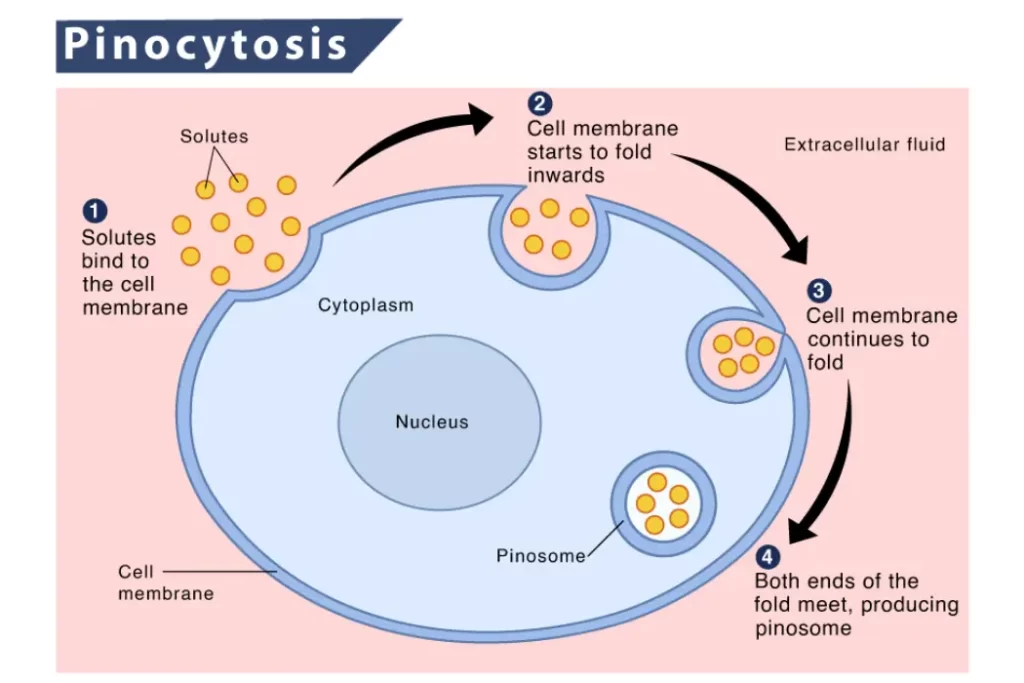Understanding the mechanisms by which cells take up extracellular fluid is crucial for comprehending various biological processes. Pinocytosis, also known as fluid-phase endocytosis, is a vital cellular process that enables cells to engulf and internalize fluids, macromolecules, and particles from their surrounding environment. Pinocytosis is a fascinating process that serves as a source of knowledge for understanding the intricate workings of the cell’s fluid uptake system. This article delves into the fascinating world of pinocytosis, exploring its mechanisms, types, functions, and significance in different biological contexts.
What is Pinocytosis?
Pinocytosis is a cellular process in which cells take in extracellular fluid and its solutes by forming small vesicles at the cell membrane. It is an essential mechanism for nutrient uptake, receptor internalization, and maintenance of cellular homeostasis. The term “pinocytosis” is derived from the Greek words “pino” (to drink) and “cytosis” (cell), indicating the cell’s ability to drink or engulf fluid.
Types of Pinocytosis
Clathrin-Mediated Pinocytosis
Clathrin-mediated pinocytosis is the most well-characterized type of pinocytosis. It relies on the assembly of clathrin-coated pits on the cell membrane, which invaginate and pinch off to form clathrin-coated vesicles. These vesicles contain the internalized fluid and molecules, which are then transported to various intracellular compartments.
Caveolae-Mediated Pinocytosis
Caveolae-mediated pinocytosis involves the formation of flask-shaped invaginations called caveolae on the cell membrane. These invaginations undergo fission and internalize extracellular fluid, delivering it to specific regions within the cell. Caveolae are rich in caveolin proteins, which play a vital role in their formation and function.
Macropinocytosis
Macropinocytosis is a non-specific form of pinocytosis that occurs in response to growth factors, signaling molecules, or changes in the extracellular environment. During macropinocytosis, the cell extends membrane protrusions, which engulf a large volume of surrounding fluid, leading to the formation of macropinosomes. Macropinocytosis is particularly important for immune cells and plays a role in antigen sampling and immune response.

Steps of Pinocytosis
Pinocytosis involves a series of coordinated steps to internalize extracellular fluid and its contents. These steps include:
Recognition and Binding
The first step of pinocytosis is the recognition and binding of the molecules or particles present in the extracellular fluid. Cell surface receptors and specific ligands facilitate this recognition process.
Vesicle Formation
Upon recognition and binding, the cell membrane invaginates, forming a small pocket or vesicle that encloses the extracellular fluid. In clathrin-mediated pinocytosis, the clathrin-coated pits contribute to vesicle formation.
Vesicle Internalization
The newly formed vesicle detaches from the cell membrane and moves into the cell’s cytoplasm. This internalization process allows the cell to sequester the engulfed fluid and its cargo.
Vesicle Fusion and Recycling
Once inside the cell, the pinocytic vesicle fuses with endosomes or other intracellular compartments. The internalized material can be further processed, recycled back to the cell membrane, or transported to specific organelles for degradation and utilization.
Regulation of Pinocytosis
Pinocytosis is a finely regulated process that can be influenced by various factors. Signaling pathways, cellular energy levels, receptor-ligand interactions, and the presence of specific molecules can modulate the rate and extent of pinocytic activity.
Significance of Pinocytosis
Pinocytosis serves multiple important functions in different biological contexts. Some of its key roles include:
Nutrient Uptake
Pinocytosis allows cells to internalize extracellular nutrients such as proteins, sugars, and lipids, ensuring their availability for cellular metabolism and growth.
Immune Response
Certain immune cells utilize pinocytosis to sample antigens from the surrounding environment. This process helps trigger immune responses and contributes to the body’s defense against pathogens.
Signal Transduction
Pinocytosis participates in signal transduction by internalizing cell surface receptors and their associated ligands. This internalization process modulates cellular signaling pathways and influences various cellular responses.
Disorders Associated with Pinocytosis
Alterations in pinocytic processes can lead to pathological conditions. Dysregulation of pinocytosis has been implicated in cancer progression, neurodegenerative disorders, and certain genetic diseases. Further research into pinocytosis and its dysfunctions may provide insights into novel therapeutic strategies.
Future Perspectives
Pinocytosis continues to be an active area of research, with scientists striving to unravel its intricacies and functional implications. Advancements in imaging techniques, cell biology, and molecular biology are contributing to a better understanding of pinocytosis and its role in health and disease.
Conclusion
Pinocytosis is a vital cellular process that enables cells to engulf extracellular fluid and its contents. Through various mechanisms such as clathrin-mediated pinocytosis, caveolae-mediated pinocytosis, and macropinocytosis, cells can internalize fluid and molecules from their environment. Pinocytosis plays essential roles in nutrient uptake, immune response, and signal transduction. By unraveling the complexities of pinocytosis, researchers are gaining valuable insights into cellular processes and disease mechanisms.
FAQs for Pinocytosis
How does pinocytosis differ from phagocytosis?
Pinocytosis involves the internalization of fluid and solutes, whereas phagocytosis refers to the engulfment of large particles or microorganisms by specialized cells.
Can pinocytosis occur in all cell types?
Yes, pinocytosis can occur in a wide range of cell types, although the extent and mechanisms may vary.
Are there any inhibitors of pinocytosis?
Yes, certain compounds and drugs can inhibit pinocytosis by interfering with the cellular machinery involved in the process.
How does pinocytosis contribute to cancer development?
Dysregulation of pinocytosis can impact cellular signaling and nutrient uptake, potentially promoting tumor growth and progression.
What research techniques are used to study pinocytosis?
Researchers use a combination of imaging techniques, genetic manipulations, and biochemical assays to study pinocytosis and its underlying mechanisms.


